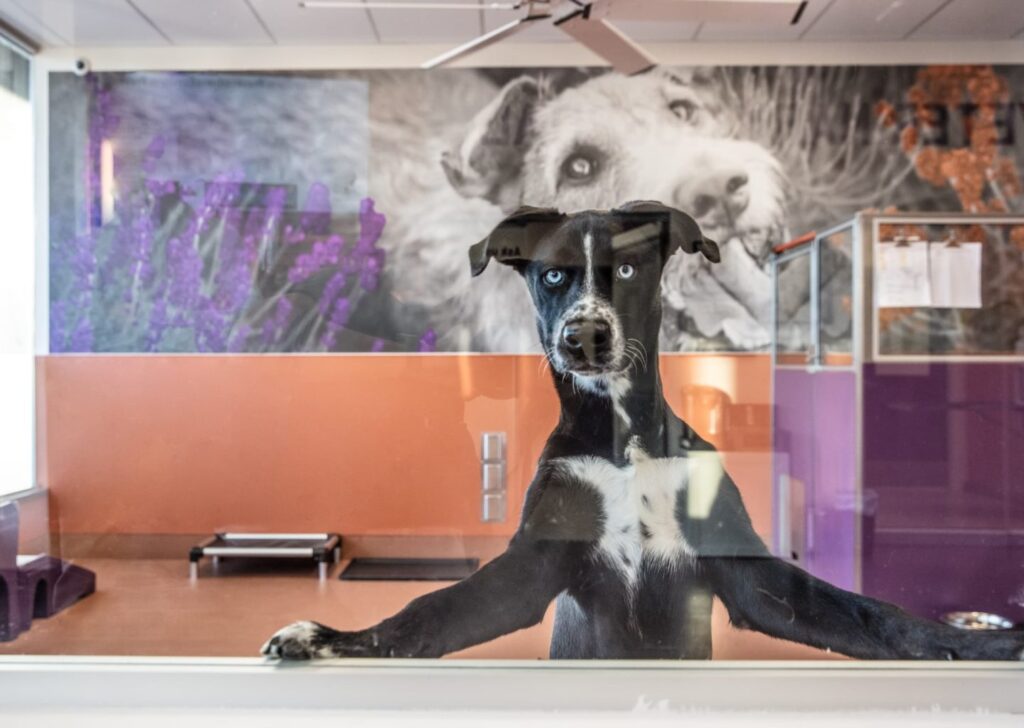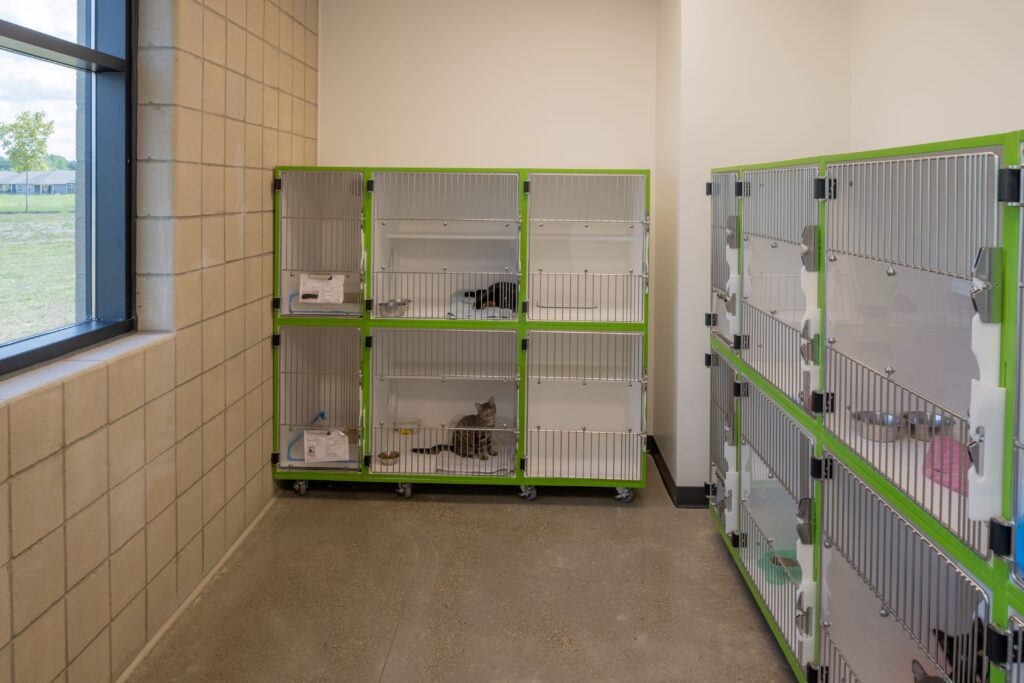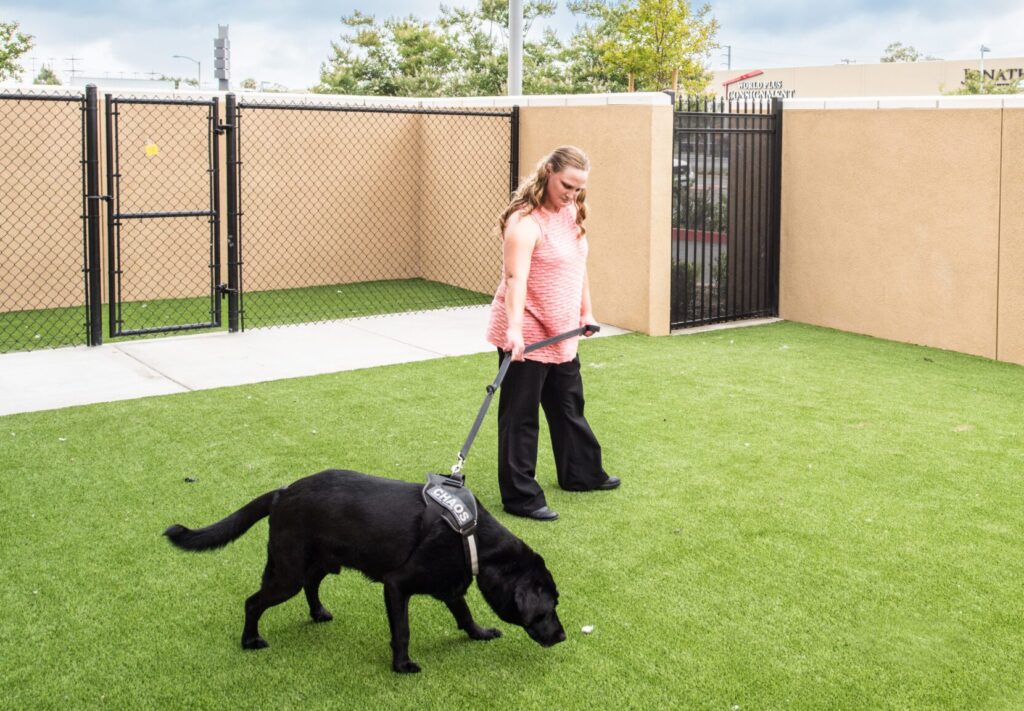On an annual average, 6.3 million pets enter U.S. shelters.
For these animals awaiting their forever homes, the shelter environment can be a source of fear and frustration. The unfamiliar sights, sounds, and smells, coupled with confinement and lack of control, can negatively impact their well-being and even their chances of adoption. Thoughtful animal shelter design plays a critical role in mitigating stress, improving animal health, and ultimately giving these pets a better chance of adoption.
Our animal care designers and architects have collectively put together some of the key design features and considerations that, in their experience, have had the most profound impact on an animal’s physical and emotional well-being during their time in a shelter. Calmer animals translate into better behavioral and physical health, which means easier handling for volunteers and staff. Plus, a more pleasant adoption experience for future pet parents. By understanding and integrating these features, your facility becomes empowered to create a healthier adoption experience and increase successful adoptions.
How Shelter Stress Can Affect Animals

Animals commonly enter the shelter scared and anxious, removed from their ‘normal’ environment and thrown into a world of unknowns. The new smells, sights, tastes, sounds, and experiences can overwhelm them. Some pets react by shutting down and becoming shy. At the same time, others may become irritated and aggressive, or energized and jumpy in new surroundings.
In addition to having dedicated staff and volunteers who compassionately care for these animals, your shelter facility can help alleviate reactivity, stress, and fear.
Minimizing Sensory Overload

One of the main stressors for a shelter animal is sensory overload. Imagine the cacophony of sounds and new sensations that come with the stereotypical animal rescue or shelter. Constant barking, meowing, and unfamiliar human interactions can create a chaotic and anxiety-inducing environment for anyone, not just pets. Targeting these overwhelming sensory triggers can look like:
- Noise Reduction Strategies: Incorporating sound-absorbing materials on walls and ceilings (like acoustic panels and specialized ceiling tiles) can dramatically reduce echo and reverberation. Other effective sound mitigation options include strategically placing animal housing away from high-traffic zones (e.g., the lobby and reception space) and providing visual barriers between enclosures using non-metal dividers. If possible, reducing the number of animals within each ward is also a simple solution to contain sounds and minimize the impact on the animals affected when one starts barking or crying.
- Optimizing Lighting: Imagine the fluorescent lighting in older facilities. It can be stressful for humans and has the same effect on animals. Natural light should be maximized throughout a shelter with plenty of windows and skylights where appropriate. If that’s not possible, using dimmable, full-spectrum LED lighting allows for a more natural and calming effect on the circadian rhythm.
- Odor Control and Ventilation: Animals have a keen sense of smell, and mixing strong odors can overload their senses. Effective ventilation systems provide ample fresh air and remove odors, which are also crucial for maintaining a healthy and clean environment. Designing for easy cleaning and the use of animal-safe cleaning products is also a simple way to contribute to better air quality.
- Visual Distractions: Limiting visibility from one canine run into another, including people or other dogs passing in front of a kennel, with frosted glass or opaque film on the lower portions of the gates can help minimize distractions and sensory triggers.
Promoting a Sense of Security and Control
The design of individual and communal animal housing areas significantly impacts an animal’s sense of security and control:
- Spacious and Comfortable Enclosures: Overcrowding has become a common crisis in shelters. Providing appropriately sized, or at the very least the USDA minimum space required, allows animals to comfortably stand, turn around, lie down, and exhibit natural behaviors. Some shelters offer a variety of enclosure sizes to accommodate the various size ranges of the animals and/or have both interior and exterior portions of the kennel for greater flexibility and animal comfort.
Source: USDA Animal Welfare
- Visual Barriers and Privacy: Constant visual contact with other animals, especially for shy or reactive pets, can be overwhelming. Incorporating partial or full visual barriers between enclosures provides animals with a sense of privacy and reduces territorial aggression and anxiety. Even a simple solid panel between caging units can produce a major difference.
- Vertical Space and Enrichment: For cats, providing vertical space such as shelves or climbing structures allows them to feel safer and more in control. Incorporating other forms of enrichment, like toys, scratching posts, and puzzle feeders, can help lessen boredom and stress.
- Species-Specific Design Considerations: A shelter that houses various types of animals must account for the unique needs of different species. Cat housing should include separate areas for litter boxes, feeding, and resting, away from each other. Dog kennels might benefit from outdoor access or views to the outside. Small animal habitats for birds, rabbits, or even horses should cater to their specific needs of burrowing, hiding, social interaction, etc.
Enhancing the Human-Animal Bond & Creating Positive Interaction Spaces

A well-designed shelter facilitates positive interactions between animals, staff, and potential adopters:
- Comfortable and Welcoming Visitation Areas: A bright, clean, and comfortable area where potential adopters can interact with animals in a relaxed setting goes a long way. Consider designated “meet-and-greet” rooms that feel less clinical and more like a home environment. Visual separation in visitation and waiting areas is also a great way to mitigate stress for different species.
- Clear Wayfinding and Intuitive Layout: A confusing layout can be taxing for visitors and staff alike. Clear signage and intuitive flow throughout the facility make it easier to find animals and for staff to efficiently carry out their responsibilities and operations. Color-coded areas or visual differences created through themed finishes can further enhance wayfinding, helping visitors orient themselves more easily while adding character and vibrancy to the facility.
- Clean and Easy-to-Maintain Spaces: Well-designed, low-maintenance environments create a positive impression on potential adopters while reducing stress for caregivers. The thoughtful selection of durable materials and interior finishes plays a vital role in supporting the well-being of visitors, staff, and animals alike.
- Dedicated Staff Areas: According to an article by Frontiers of Animal Protection, animal protection and welfare workers face a notable amount of stress. From compassion fatigue and witnessing traumatic surrenders and sick animals, to burnout from difficult working conditions and coworker dynamics, a lack of training and support, poor management, and challenges related to external conditions such as a lack of funding and public apathy, the list goes on for what these selfless professionals encounter. Providing staff and volunteers with well-designed, comfortable, and functional workspaces, including break rooms and quiet areas, can help reduce the mental and emotional strain, improving their ability to provide optimal care for the animals. When staff feel supported, the animal’s benefit, and the shelter can lessen staff turnover and employee dissatisfaction.
Investing in Well-being: A Holistic Approach to Shelter Design

Ultimately, designing a less stressful and more adoptable animal shelter requires a holistic approach that considers the needs of all users – animals, staff, and visitors. By prioritizing acoustics, lighting, ventilation, thoughtful housing, and positive interaction spaces, shelters can create environments for animals that do more than better their experience; they can:
- Reduce animal stress and anxiety, leading to improved physical and behavioral health
- Increase adoption rates by showcasing calmer and happier animals
- Improve staff morale and efficiency by providing a more pleasant and functional work environment
- Create a more positive and welcoming experience for visitors, encouraging community engagement
Written By MD Architects
MD Architects is a full-service, relationship-based firm dedicated to providing superior planning, design, specifications, and construction guidance to animal care, human healthcare, and commercial industries.
September 16, 2025




